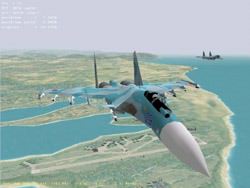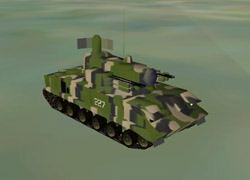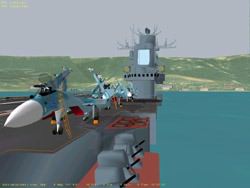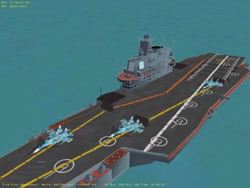By: Ed Reddy and Mark Shepheard
Date: 1999-01-19

Formation over Sevastopol
Ed Reddy's Take on Flanker 2's Features:
Remember your first roller coaster ride? You stood in line for an hour,
the tension you felt in your stomach as your mom or dad squeezed your
hand to give you that reassurance. Finally you stepped up to the track
and into your car… the greasy haired kid came by and made sure the
safety bar is securely around your shoulders. The cars lurched forward
and you climbed slowly up the track. You feel a mile high at the top
and suddenly you are released…the wind blasted at your face so fast
your eyes watered over, and you put your hands into the air and
screamed like you've never screamed before as you do your first
loop…what a ride!
Flanker 2 almost had the same effect for me when I took off down the runway, except I didn't feel any wind and my eyes were clear as a bell. The aircraft I commanded wobbled a bit from the thrust and as I slowly pulled back on my control stick the Su-33 slowly climbed into the air. I took in the landing gear and climbed to 3000 meters. The terrain looked amazing as it quickly slipped under the belly of my plane. Buildings appeared as I flew over the Crimean city of Sevastopol with amazing ground detail. What a ride!
When Su-27 Flanker V1.0 was released a few years back, I thought this simulator was the cat's meow. In the business world, one mantra for success is "location location location". In the flight sim world, the mantra is "detail detail detail." Detailed graphics, detailed flight model, detailed artificial intelligence, detailed modeled SAM and Ships, and detailed weapons. My opinion is that Flanker scored a perfect 10 in all categories, except for graphics, but we can live with a perfect sim without eye candy. As they say "Eye candy is dandy, but being real is the deal". It was not an easy simulator to fly, a number of so-called hardcore pilots gave up on this gem because they could not master the avionics. Well Chuck Yeager once said 'It's the man, not the machine" and the same applies to Su-Flanker. Flanker 1.5 (in its latest form) offers realistic weapons model performance. Expect that S300 to track your bird as accurately as it does in real life. But for those who are disheartened by the difficult flight model from the original version - rejoice. Flanker 2 will have scalable difficulty levels. This means all simulator pilots, at all skill levels, will be able to taste the Flanker experience that for so long was relegated to only the most hardcore fliers.
So, what are the changes for Flanker 2 over the current version?
- Graphics - the current alpha build I have allows for
1024x768, Direct3D, OpenGL, or software driven. Expect support for most
graphic chips in resolutions up to 1024x768 (and maybe higher). At
1024x768 the land scenery looks fantastic…and it's not the final
mip-mapped version either! For those of you still languishing in
hardware hell (like I was until recently), Flanker 2 can be configured
to run on your slower machine by tuning down the graphics.
- Weapons - many more soviet weapon types have been
added, including different S300 variants (as if the S300 truck mounted
ones weren't nasty enough!) Weapon modeling has been tweaked. Expect
more realistic performance, accurate lock distances, and better damage
effects from the already perfect version 1.5 (God help us).
- Damage - over 20 damage points on the Flanker alone
have been modeled… no longer will you loose an engine from a single
hit. Expect damage modeling on wing surfaces, drastically effected
flight characterists, loss of speed and other realistic modeling from
damage effects to your aircraft and other objects in the air and ground.
- FlightModel - I'll let my buddy Mark "Stinger" Shepheard explain this one below!
- Vehicles - Flanker 2 will have the extensive weapons
modeling in the SAM batteries. Expect lots more detail and accuracy in
the SAM vehicles and more realistic artificial intelligence. Even the
SAM trucks have engine noise…you can actually hear the engine running
when you view a vehicle - detail again.

Don't get too close to this Tunguska! - Ships - all have moving radar arrays modeled
accurately from the real McCoy. And again, move your view to the stern
of the ship and you can hear the engine rumble. Oh my!
- Carrier Operations - Flanker 2 will employ carrier operations. Airports at sea on a moving
ship. Trying to land on the Russian or the American carrier without ILS
is near impossible. It's an exact science which makes you respect the
Navy pilots who have to fly in all kinds of weather conditions and land
on a moving, dipping, and rolling deck. This brings a new element into
the Flanker realm. Carrier Ops opens an exciting twist into an already
packed product. With the new ships added, it's possible to create
American and Russian/Ukrainian Carrier groups as opposing forces. The
types of scenarios you can build with the powerful Flanker mission
editor (best in the sim industry) is mind numbing.
- Detail - ever hear a kitten purr? Ever hear the engine rumble on a ZSU-23? The enormous growl from an American Nimitz carrier? Every vehicle with an engine runs, every radar dish turns. They have put a lot of work in putting detail into the objects. Camouflage patterns are painted nicely, gun turrets on the Carriers are there as they should be, antenna wires and poles are there as they exist in real life. Nothing better than to sit back and listen to aircraft take off from the deck of a carrier…watch them taxi and park, the cockpit opens up and wheel chaks appear. Wow!
Many more features are planned but have not been finalized, therefore I cannot comment on any of these until I see them for myself in the next release. Now, I will yield the floor so Mark Shepheard can talk about the much improved Flight Model.

Su-33's, wings folded and wheels chocked on Kuznetsov
Mark Shepheard's Take on Flanker 2's Flight Model:
We all
know how Flanker 1.0 through 1.5 has been touted for accurately
re-creating the flight model and immersive sensations of flying a
fighter jet. Well, Flanker 2 takes these already impressive features of
its predecessors and takes them to a new level --- a level that is
beyond any flight sim I have flown to date. As Ed said earlier,
"details, details, details". So enough with the subjective hyperbole.
Here are my observations of Flanker 2's flight model development to
date.
The first astonishing improvement I noticed on my first flight is that when I did a full afterburner take off, the scenery flew by me in a flash. The sense of speed in Flanker 2 is at least twice that of Flanker 1.5...WOW! The entire aircraft feels heavier and much less twitchy than Flanker 1.5 as it displays a slower roll rate more in tune for an aircraft of its size. It feels like there is more inertia and weight modeled as well as drag when the brake, gear, or flaps are deployed. Control surface response at different airspeeds is very well modeled and the aircraft becomes sluggish in slow flight requiring larger stick deflections compared to when the aircraft is at higher speeds. Aileron reversal near critical AoA is also there which is a part of the envelope that is often missed in other sims. There is more speed bleed in high G turns than 1.5 with "Nagging Nadia" letting you know when you have reached, "Maximum G" and "Maximum Angle of Attack". Accelerated stalls are very well modeled when exceeding the critical angle of attack. Stalls are very well modeled and adding flaps will increase lift and decrease the stall speed as that is what happens in the real world. Any type of yaw when stalled will put you into an incipient spin and if you don't react quickly you'll be in a full spin in no time. Spin recovery is also well modeled needing opposite rudder and then a good pitch forward to break the stall once the rotation has stopped and you can really feel it breaking the stall. Inverted flat spins are also possible and are recoverable with the proper control inputs but are much tougher to get out of. Another well done aspect of the flight model is the altitude effects, both a higher True Airspeed as well as less fuel burn at the upper altitudes. Airframe efficiency is also degraded at altitude, as it should be.
On approaching to land it is just like the real thing...attitude plus power equals performance and once you have the flaps, brake, hook and gear out and are on glideslope you set your power and make small adjustments to keep it stable. Compared to Flanker 1.5 you will have to hold a higher angle of attack on approach due to the better drag modeling and that runway comes at you fast! I also was able to easily do a forward slip that is used to decrease altitude at a high rate but not increase airspeed. This is done by banking a wing, applying opposite rudder to the bank, and pushing the nose forward which puts the side of the airframe into the airflow and acts as a very large airbrake.
The differences in the Su-33 as compared to the Su-27 are many and starting with the physical characteristics are as follows:
The Su-33 has forward canards just aft of the cockpit that generate extra lift forward of the center of gravity which is required for carrier take offs and landings. It also has split flaps and outboard ailerons instead of the flaperons on the Su-27. The split flaps extend to about 60 degrees to aid in the approach to the ship by decreasing the angle of attack and are, "split" in order to accommodate the folding wings when stored on the carrier deck. The tailerons also fold up and the gear of the Su-33 is much stronger with dual wheels on the nosegear as well as beefed up front and rear struts. There is also of course the box section tailhook under the tailcone and a nose mounted retractable in-flight refueling probe.
The Admiral Kuznetsov aircraft carrier has no steam catapults and the jump ramp on the bow gives the Su-33 enough vertical momentum to allow it the few seconds needed to accelerate to a climbout speed. The flight model seems excellent here in that after the initial jump off the ramp you still have a few seconds of settling towards the water just prior to reaching a climbout speed, It feels very good! The approach to the ship in the Su-33 is somewhat different then the Su-27 since the large split flaps at 60 degrees create a lot of drag so a good amount of power is needed to maintain a stable approach. The ship comes up very fast and disappears under the nose on short final followed by a controlled crash onto the deck catching one of the four wires.
As a note, with my head down in the cockpit I was able to complete a full approach to the deck from the outer marker catching the 3 wire all by the panel instruments alone with no HUD or outside reference. Flanker 2's instruments and flight model are THAT accurate...I was very impressed to say the least! The Su-33 also has different in-flight characteristics including different stall speeds and higher maneuverability then the Su-27 from what I found.

Su-33's prepare for take-off
In summing up, the Flanker 2 flight model is everything Flanker 1.5 was and much much more, it is very smooth and fluid an will convince even the most demanding sim pilot as well as any real pilot. The bar on flight models has been raised above and beyond anything seen to date and is a credit to the team from Eagle Dynamics.
| F-18's ready for launch | Kuznetsov with aircraft |
| Russian Fleet | S300 PMU | Refuelling | F-18 Landing |
| Su-33 Landing | Tu-160 |